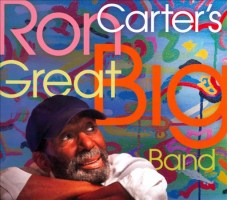Home » Jazz Articles » Album Review » Ron Carter's Great Big Band: Ron Carter's Great Big Band
Ron Carter's Great Big Band: Ron Carter's Great Big Band
Carter has never led a big band outing, until now. With charts by esteemed arranger Robert M. Freedman, Carter leads a seventeen-piece ensemble through a set of jazz standards on Ron Carter's Great Big Band, from the much-covered Duke Ellington vehicle, "Caravan," to trumpeter Tom Harrell's "Sail Away" and trumpeter Dizzy Gillespie's "Con Alma."
Carter put out an excellent small group outing this millennium, When Skies Are Grey (Blue Note Records, 2001). The cover art—a photo of a grey clad, regal-looking Carter gazing over a drab cityscape at overcast skies—had a limited color spectrum, and the music leaned toward the serious side, as much of the classically-trained Carter's art does, but Ron Carter's Great Big Band is a bright, colorful experience, from the rainbow-ish cover art and the dancing sparkle of W.C. Handy's "Saint Louis Blues," to the joyful ebullience and New Orleans tinted cover of trumpeter Nat Adderley's "Sweet Emma" and the pastel elegance swirling over the trombone section's dark backdrop on the bassist's own "Loose Change."
The band's drive train—the rhythm section of pianist Mulgrew Miller and drummer Lewis Nash, along with Carter—is as solid as they come. Carter's bass rides higher in the mix than is normally heard on a large ensemble set---a big, warm, inexorable heartbeat inside the flash and cool washes of brass and reeds.
"Footprints," penned by Carter's former Davis cohort, Wayne Shorter, and included on the saxophonist's Adams' Apple (Blue Note, 1966) as well as Davis' Miles Smiles (Columbia, 1967)—on which Carter played— maintains its ominous mood here, with splashier harmonics afforded from the multiple horns, while John Lewis' "The Golden Striker" gets a jaunty, upbeat treatment.
Like saxophonist Joe Henderson and his outstanding Big Band (Verve, 1997), Carter has taken his first shot at leading a large group later in his career, and he's produced a gem with Ron Carter's Great Big Band.
Track Listing
Caravan; The Eternal Triangle; Pork Chop; Opus 1.5 (Theme for C.B.); Con Alma; Sail Away; Opus 1; Sweet Emma; Saint Louis Blues; Line for Lyons; Footprints; The Golden Striker; Loose Change.
Personnel
Robert M. Freedman: arranger and musical director; John Dodgion: alto and soprano saxophones; Steve Wilson: alto saxophone; Wayne Escoffery: tenor saxophone; Scott Robinson: tenor saxophone; Jay Brandford: baritone saxophone; Charles Pillow: English horn; Jason Jackson: trombone; Steve Davis: trombone; James Burton III: trombone; Douglas Purviance: bass trombone; Tony Kadleck: trumpet, flugelhorn; Greg Gisbert: trumpet, fluglehorn; Jon Owens: trumpet, fluglehorn; Alex Norris: trumpet, flugelhorn; Ron Carter: bass; Mulgrew Miller: piano; Lewis Nash: drums.
Album information
Title: Ron Carter's Great Big Band | Year Released: 2011 | Record Label: Sunnyside Records
< Previous
Wynton Marsalis' Swinging Into The 21...
Next >
Looking Out, Looking In
Comments
Tags
For the Love of Jazz
 All About Jazz has been a pillar of jazz since 1995, championing it as an art form and, more importantly, supporting the musicians who create it. Our enduring commitment has made "AAJ" one of the most culturally important websites of its kind, read by hundreds of thousands of fans, musicians and industry figures every month.
All About Jazz has been a pillar of jazz since 1995, championing it as an art form and, more importantly, supporting the musicians who create it. Our enduring commitment has made "AAJ" one of the most culturally important websites of its kind, read by hundreds of thousands of fans, musicians and industry figures every month.



















